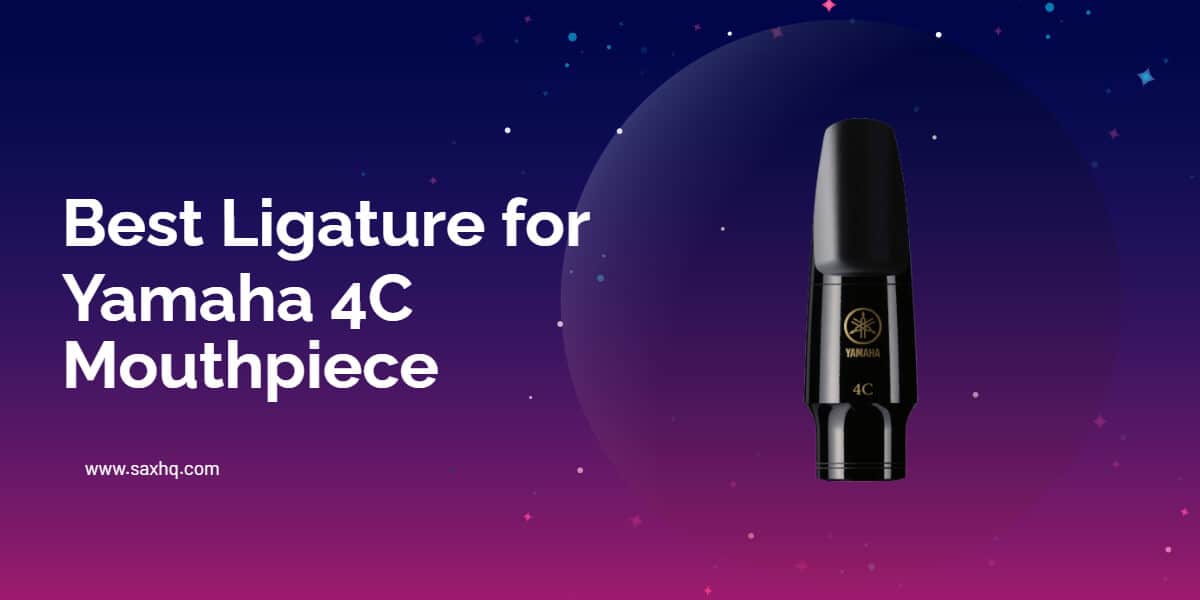Sometimes, you can’t reach your mouthpiece’s full potential unless you pair it with a good ligature. Being a top-notch mouthpiece, it’s only fair to pair your Yamaha with a ligature that brings out the best in it.
So, what’s the best ligature for Yamaha 4C mouthpiece? Keep on reading for a list of possible options.
Table of Contents
Best Ligature for Yamaha 4C Mouthpiece
Ligatures typically come as add-ons with the mouthpiece you buy. However, some stand-alone options are crafted to bring out the best in your mouthpiece. Here’s a list of the top options.
1- Yamaha YAC 1607 Alto Saxophone Ligature
The Yamaha YAC 1607 is the most budget-friendly ligature option you can get for your 4C mouthpiece, and it fits perfectly as it’s coming from the same brand.
It comes with a lacquered brass finish that gives it an aesthetic golden look. Besides adding a nice appearance to your Yamaha setup, the ligature works with any Yamaha mouthpiece.
Not only that, but it fits plenty of other mouthpiece brands, too. It comes with two screws that allow you to tighten it as you please without any unevenness.
The Yamaha YAC 1607 is a highly affordable option, but it doesn’t have any bells and whistles. It doesn’t do a myriad of things, but it does what it does exceptionally well.
If you’re a student or a beginner and you’re only experimenting with saxophones, it’s a pretty solid option.
Recommended: Buescher Aristocrat alto saxophone review
2- Rovner X-1RL Alto Saxophone Ligature
You can get the rubber variant, which is the Rovner X-1RL, or the metal variant, the X-1M for around six extra bucks.
Rovenr’s rubber ligature gives your setup a focused, rich sound that tends more toward dark tones. However, it’s versatile enough to play other styles if you want to—which is why it’s a good fit with the 4C mouthpiece that helps you play in any octave.
The ligature comes with flaps that you can reposition according to your needs. Its cradle is made of a high-quality metal alloy that contributes to its versatility.
In other words, you can do some exploration and hit different tonal spectrums without having to worry about intonation or your scales being uneven.
Finally, the Rovner ligature allows your mouthpiece and reed to give you the full sound projection in every register.
However, it’s worth noting that this ligature is quite expensive compared to the average options on the market. The metal variant is even more so.
So, if you’re not an invested or professional player, you might want to look at a more budget-friendly option.
3- D’Addario HAS1G Woodwinds H-Ligature & Cap
If you’re looking for something in between, the D’addario HAS1G would serve you well. It does offer some extras that a typical beginner ligature wouldn’t bother with, yet it doesn’t break the bank.
It comes at an average price that feels justified if you want to take up your performance on the sax up a notch or two.
This is especially true when you think about how it was conceived as the “retro” version of the Harrison ligature.
Unlike student options, it’s gold-plated, which makes it more stable and therefore the overall sound crisper.
The mouthpiece integrates a four-point “H” system technology that distributes the pressure equally on the reed. This increases the efficiency of holding the reed to the table of the mouthpiece, enhancing contact and eliminating any leaks that can happen along the side rails.
Not only that but it’s also equipped with a two-screw inverted design and additional support to the ligature’s brackets to improve the durability of the ligature.
Finally, the ligature comes with a mouthpiece cap that’s made of over-molded plastic, making it quite soft yet protective.
Recommended: The best alto sax cases on the market
How Does a Ligature Affect the Sound of a Saxophone?
Your saxophone produces a sound with the vibrations of both its reed and its mouthpiece. The ligature is the connecting part between those two, and the vibrations of the ligature affect the overall sound of the saxophone.
The better the quality of your ligature, the easier and faster the notes will come out with a cleaner and crisper sound.
It also helps you articulate the notes, which further enhances your capability to play the horn with the exact sounds you have in mind—nothing is lost in translation. Or perhaps it’s better to say nothing is lost in vibration.
Final Thoughts
Choosing a ligature has the least methodology to it. Unlike mouthpieces and reeds, there aren’t various sizes and specs that affect the performance.
After all, a ligature is a highly function-oriented element on your sax. That’s why it’s best if you choose one that minimizes vibrations and you’re good to go.
This is also why trying the ligature to see how it fits with the mouthpiece and setup you already have is the optimum route.
A big part of the process relies on your preference and how the ligature feels when you integrate it into your setup.




